easyJet Bundle
How did easyJet revolutionize air travel?
Launched in 1995, easyJet, a British low-cost airline, has dramatically reshaped the European aviation landscape. Founded by Sir Stelios Haji-Ioannou, the airline aimed to make air travel accessible to everyone, mirroring the success of Southwest Airlines. Its iconic orange livery and simple pricing strategy quickly became synonymous with affordable air travel across Europe.
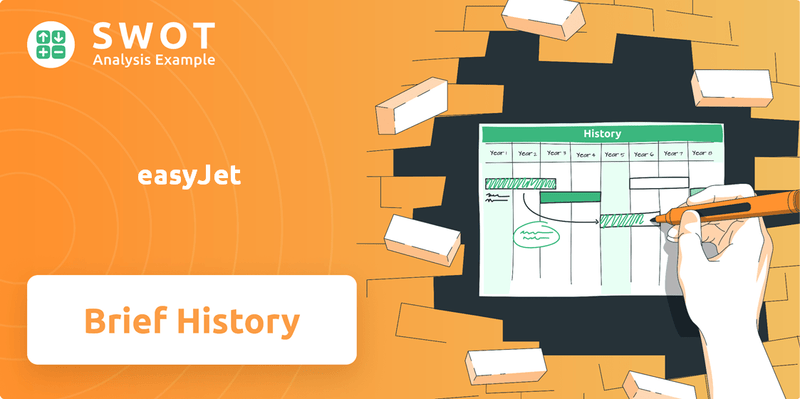
From its initial two leased Boeing 737s, the easyJet SWOT Analysis reveals a company that has expanded to become one of Europe's largest airlines. This brief history of easyJet explores its founding, rapid growth, and key innovations that have shaped its journey. Understanding the easyJet company timeline is crucial for appreciating its impact on the industry and its future prospects. The easyJet fleet and its evolution over time are also key components.
What is the easyJet Founding Story?
The story of the easyJet company began in March 1995. It was the brainchild of Sir Stelios Haji-Ioannou, a Greek-Cypriot entrepreneur. The airline launched its operations on November 10, 1995, with flights from London Luton Airport to Glasgow and Edinburgh.
Sir Stelios used his family's wealth to fund the venture, investing £5 million. He started with two wet-leased Boeing 737-200 aircraft. The aim was to make air travel more affordable and accessible to a wider range of people.
The core problem easyJet addressed was the high cost of air travel in Europe. Sir Stelios adopted a low-cost, no-frills model, similar to Southwest Airlines. This model focused on price elasticity to attract passengers. The initial one-way fare of £29 was a groundbreaking move, making air travel more accessible.
easyJet's early success was driven by its low fares and innovative marketing.
- easyJet's initial business model was simple: offer low fares with extra charges for services.
- The airline's advertising campaign, which featured its phone number on the aircraft, was very memorable.
- easyJet's name was chosen to highlight its commitment to making air travel easy and affordable.
- Early flights were operated by GB Airways and Air Foyle HeavyLift until October 1997.
The airline's early days saw it tackling challenges. One of these was obtaining its own Air Operator's Certificate. The airline initially operated flights through other companies. This continued until October 1997.
easyJet SWOT Analysis
- Complete SWOT Breakdown
- Fully Customizable
- Editable in Excel & Word
- Professional Formatting
- Investor-Ready Format
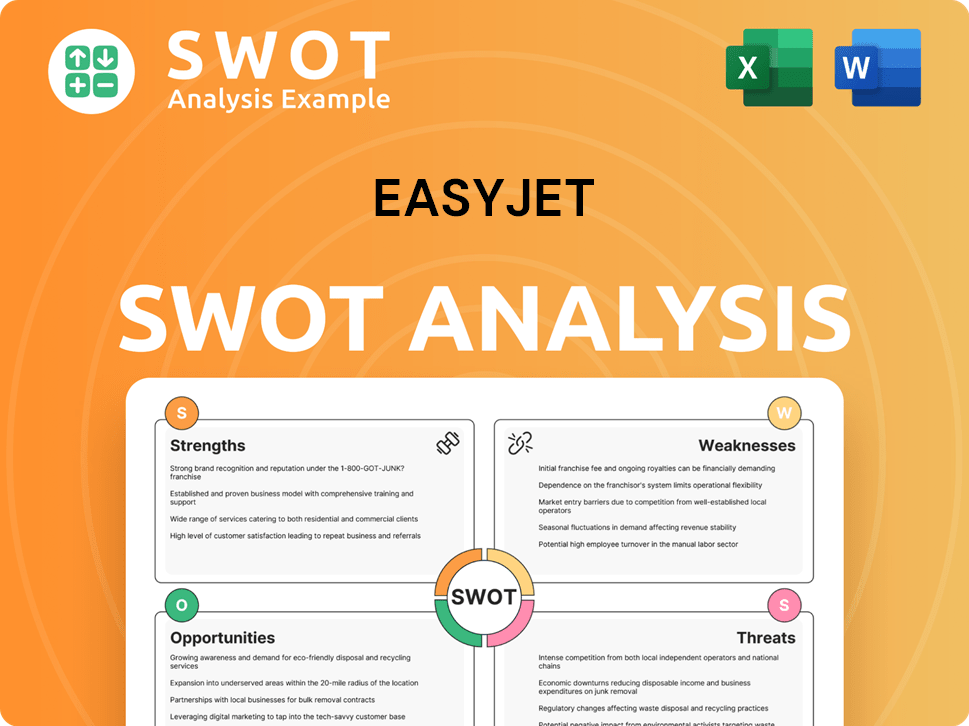
What Drove the Early Growth of easyJet?
The early growth of the easyJet company was marked by rapid expansion in routes and fleet size, driven by strong consumer demand for affordable air travel. The airline quickly established itself as a major player in the low-cost airline sector. This period saw strategic acquisitions and the opening of numerous bases across Europe, solidifying its position in the market.
After launching its first international route to Amsterdam in April 1996, easyJet expanded to Nice and Barcelona. By autumn 1997, the airline established its second UK base at Liverpool Airport. A key move in 1998 was acquiring a 40% stake in TEA Basle, which became easyJet Switzerland, marking its first base outside the UK at Geneva Airport.
A pivotal moment in the easyJet timeline was its listing on the London Stock Exchange in November 2000, raising significant capital. In 2002, easyJet acquired its rival low-cost airline, Go Fly, from British Airways for £374 million. This acquisition nearly doubled easyJet's fleet of Boeing 737-300 aircraft and added three new bases.
Between 2003 and 2007, easyJet expanded its presence across Europe, opening bases in Germany, France, Italy, and Spain. By 2004, a new base was opened in Berlin, and flights to Hungary and Slovenia were launched. By 2007, easyJet was operating more flights per day than any other European airline.
In June 2011, easyJet opened its eleventh British base at London Southend Airport. In January 2012, it expanded further by opening four new bases in Lisbon, Southend, Toulouse, and Nice. This aggressive expansion and strategic acquisitions solidified easyJet's position as a major player in the European low-cost airline market.
easyJet PESTLE Analysis
- Covers All 6 PESTLE Categories
- No Research Needed – Save Hours of Work
- Built by Experts, Trusted by Consultants
- Instant Download, Ready to Use
- 100% Editable, Fully Customizable
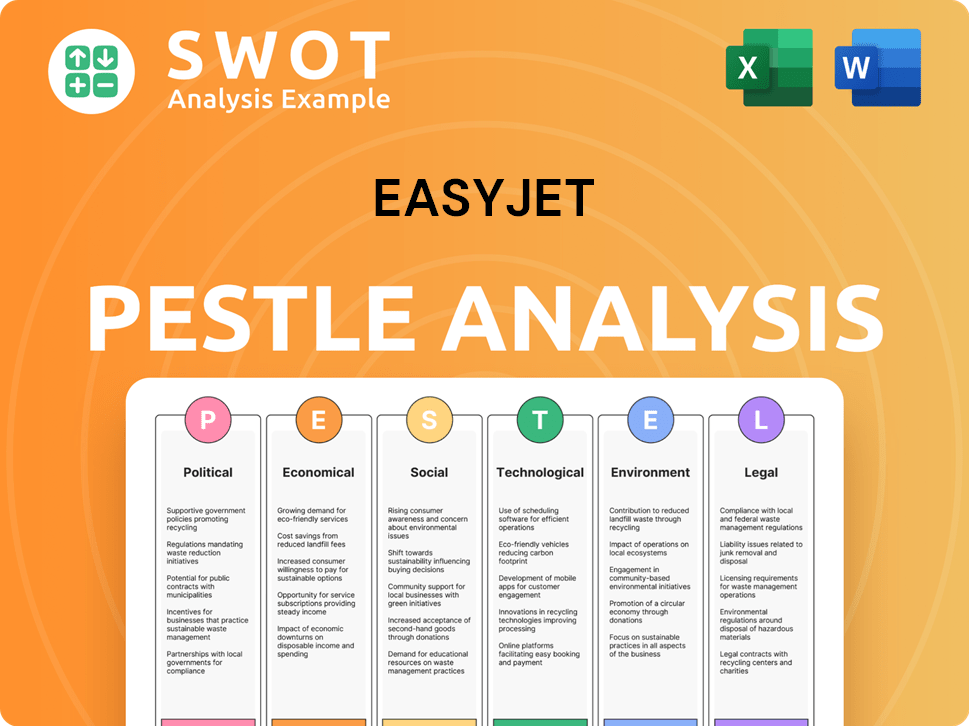
What are the key Milestones in easyJet history?
The easyJet history is marked by several key milestones that have shaped its growth and influence in the aviation industry. From its inception, the easyJet company has consistently expanded its operations and adapted to market changes, solidifying its position as a leading low-cost airline.
| Year | Milestone |
|---|---|
| 1999 | Voted 'Best Low Cost Airline' for the first time, showcasing early recognition in the industry. |
| 1997 | Launched easyJet.com, pioneering online bookings and transforming the way tickets were sold. |
| 1998 | Actively promoted and sold tickets online, leading to ten million tickets sold via the internet over the next four years. |
| 2006 | Became the first major low-cost airline to offer internet check-in for its UK passengers. |
| 2019 | Launched easyJet holidays, expanding into package holidays and diversifying its offerings. |
| 2019 | Became the first major airline to offset 100% of the carbon emissions from the fuel used for all its flights. |
| 2024 | Signed an agreement with Moeve for the supply of sustainable aviation fuel (SAF) until 2030, with access to SAF for its Spanish network from 2025. |
The easyJet company has been at the forefront of several innovations that have redefined the low-cost airline model. The early adoption of online booking and check-in systems significantly streamlined operations and enhanced customer experience.
Launched easyJet.com in April 1997, revolutionizing ticket sales. By 1998, online sales were actively promoted, leading to rapid growth in internet ticket sales.
Introduced internet check-in in 2006, enhancing passenger convenience. This was a pioneering move for a major low-cost carrier at the time.
Transitioned from an all-Boeing 737 fleet to an all-Airbus fleet starting in 2003. This strategic shift improved efficiency and operational flexibility.
Launched in November 2019, providing package holidays directly to customers. This arm has delivered a £44 million profit in the first half of FY25, up £13 million year-on-year.
Became the first major airline to offset 100% of its carbon emissions. This commitment includes a roadmap to net-zero emissions by 2050.
Signed an agreement with Moeve for the supply of sustainable aviation fuel (SAF) until 2030. This initiative supports the airline's sustainability goals.
Despite its successes, easyJet has faced numerous challenges, including economic downturns and global events. The airline's share price has seen volatility, and it continues to navigate external pressures.
The 2009 global financial crisis affected the aviation industry. easyJet responded by targeting business travelers to diversify its customer base.
The COVID-19 pandemic forced easyJet to ground its entire fleet in March 2020. The company secured a £600 million loan from the UK government to mitigate the impact.
Recent disruptions in air traffic control have posed operational challenges. These disruptions have impacted flight schedules and operational efficiency.
Fluctuations in energy prices have affected operational costs. The airline is working on strategies to manage and mitigate these costs.
Cost-of-living pressures have influenced consumer behavior and demand. The airline is adapting its strategies to address these economic factors.
The airline's share price fell 8.9% in the 12 months to January 28, 2025, despite strong financial results. This reflects market uncertainties and industry challenges.
To remain competitive, easyJet has implemented strategic adjustments. For a deeper understanding of the competitive landscape, consider reading about the Competitors Landscape of easyJet.
easyJet Business Model Canvas
- Complete 9-Block Business Model Canvas
- Effortlessly Communicate Your Business Strategy
- Investor-Ready BMC Format
- 100% Editable and Customizable
- Clear and Structured Layout
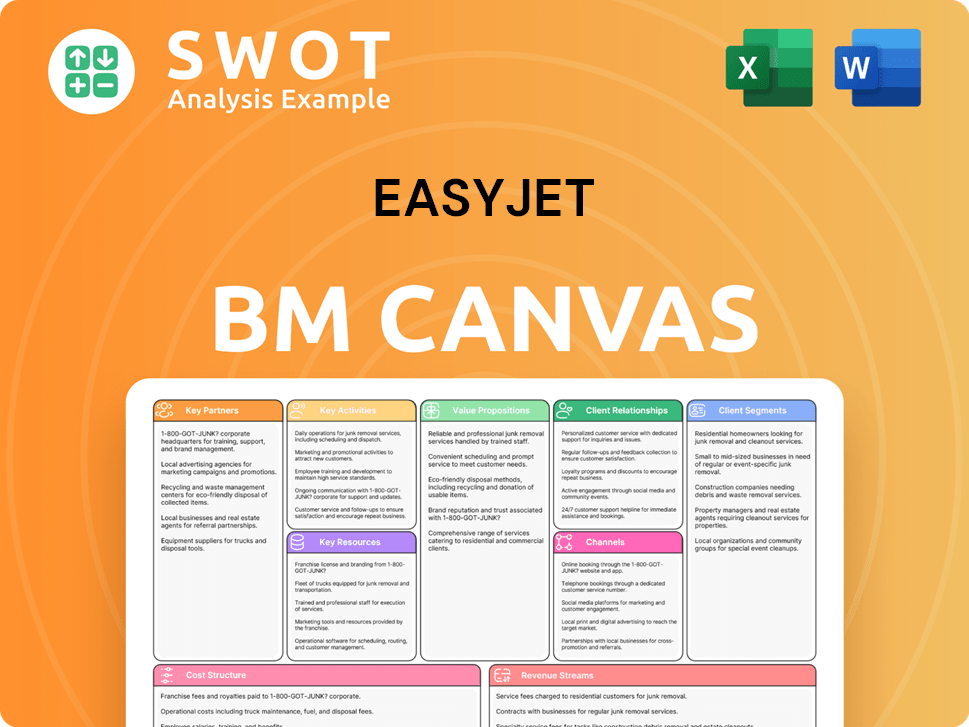
What is the Timeline of Key Events for easyJet?
The easyJet history is marked by significant milestones, from its inception to its current position as a major player in the airline industry. Founded in 1995 by Sir Stelios Haji-Ioannou, the easyJet company quickly established itself as a leading low-cost airline, expanding its routes and fleet. The easyJet timeline includes strategic acquisitions, public listings, and a commitment to sustainability, shaping its trajectory and impact on European travel.
| Year | Key Event |
|---|---|
| 1995 | easyJet is founded by easyJet founder Sir Stelios Haji-Ioannou, with initial flights from London Luton. |
| 1996 | International routes to Amsterdam, Nice, and Barcelona are launched. |
| 2000 | easyJet goes public, listed on the London Stock Exchange. |
| 2002 | easyJet acquires Go Fly. |
| 2003 | easyJet shifts to an all-Airbus fleet. |
| 2006 | easyJet introduces internet check-in in the UK. |
| 2007 | easyJet acquires GB Airways. |
| 2013 | easyJet is promoted to the FTSE 100 Index. |
| 2018 | The easyJet fleet reaches 300 aircraft. |
| 2019 | easyJet holidays is launched, and easyJet offsets 100% of carbon emissions. |
| 2020 | Entire fleet grounded due to the COVID-19 pandemic. |
| 2022 | easyJet announces its net-zero roadmap by 2050. |
| 2023 | Kenton Jarvis is announced as the new CEO. |
| 2024 | easyJet announces new routes and fleet growth. |
| 2025 | easyJet plans to open new bases at Milan Linate and Rome Fiumicino airports. |
For fiscal year 2025, easyJet anticipates carrying approximately 103 million passengers. This represents a 3% increase in passenger capacity, reflecting continued growth in the airline's operations and market share. This expansion is a key indicator of the airline's ability to attract and retain customers.
easyJet aims for an 8% year-on-year growth in Available Seat Kilometres (ASK). easyJet holidays is also set for substantial growth, with a target of 25% year-on-year customer growth. These targets highlight the company's strategic focus on expanding its operational capacity and diversifying its offerings.
Analysts project approximately 60% pre-tax profit growth from FY2024 to 2028. easyJet is confident in achieving its medium-term target of over £1 billion in profit before tax. This financial outlook demonstrates the company's strong growth potential and its ability to generate substantial returns.
easyJet is expanding its route network, particularly on longer leisure routes, and investing in technology. The airline is committed to fleet modernization, with an agreement with Airbus for 157 new aircraft from 2029. Furthermore, easyJet is intensifying its sustainability efforts, including the use of Sustainable Aviation Fuel (SAF) and continued development of zero-emission technologies like hydrogen.
easyJet Porter's Five Forces Analysis
- Covers All 5 Competitive Forces in Detail
- Structured for Consultants, Students, and Founders
- 100% Editable in Microsoft Word & Excel
- Instant Digital Download – Use Immediately
- Compatible with Mac & PC – Fully Unlocked
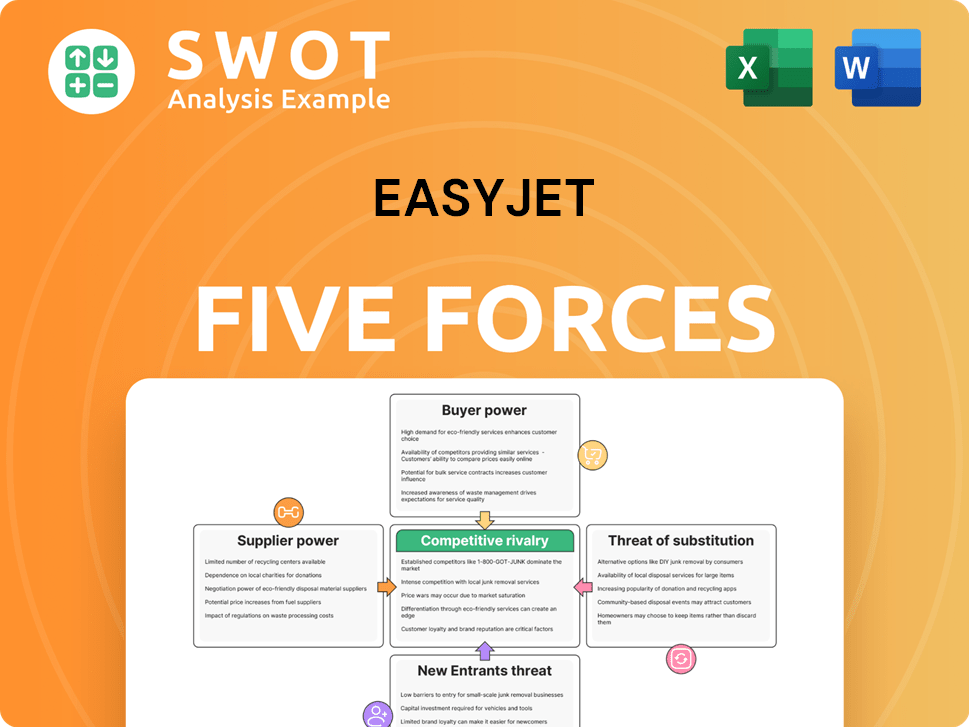
Related Blogs
- What is Competitive Landscape of easyJet Company?
- What is Growth Strategy and Future Prospects of easyJet Company?
- How Does easyJet Company Work?
- What is Sales and Marketing Strategy of easyJet Company?
- What is Brief History of easyJet Company?
- Who Owns easyJet Company?
- What is Customer Demographics and Target Market of easyJet Company?
Disclaimer
All information, articles, and product details provided on this website are for general informational and educational purposes only. We do not claim any ownership over, nor do we intend to infringe upon, any trademarks, copyrights, logos, brand names, or other intellectual property mentioned or depicted on this site. Such intellectual property remains the property of its respective owners, and any references here are made solely for identification or informational purposes, without implying any affiliation, endorsement, or partnership.
We make no representations or warranties, express or implied, regarding the accuracy, completeness, or suitability of any content or products presented. Nothing on this website should be construed as legal, tax, investment, financial, medical, or other professional advice. In addition, no part of this site—including articles or product references—constitutes a solicitation, recommendation, endorsement, advertisement, or offer to buy or sell any securities, franchises, or other financial instruments, particularly in jurisdictions where such activity would be unlawful.
All content is of a general nature and may not address the specific circumstances of any individual or entity. It is not a substitute for professional advice or services. Any actions you take based on the information provided here are strictly at your own risk. You accept full responsibility for any decisions or outcomes arising from your use of this website and agree to release us from any liability in connection with your use of, or reliance upon, the content or products found herein.